Bonxies on a boat
Great Skuas, Stercorarius skua, are known as Bonxies in Orkney. Their flashing go-faster white wing-stripes are a familiar sight as they patrol along the coasts:
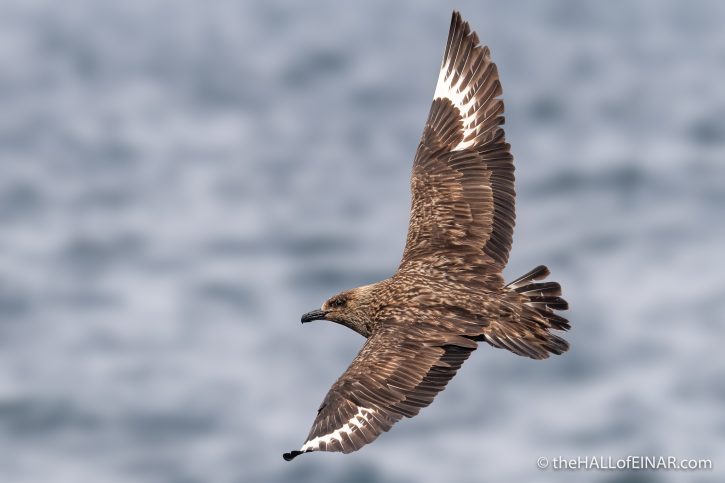
I’m loving being so close to Bonxies today. Being on a boat means they’re less likely to be disturbed by me and I have the chance of a few more intimate shots and a clearer view of their behaviour.
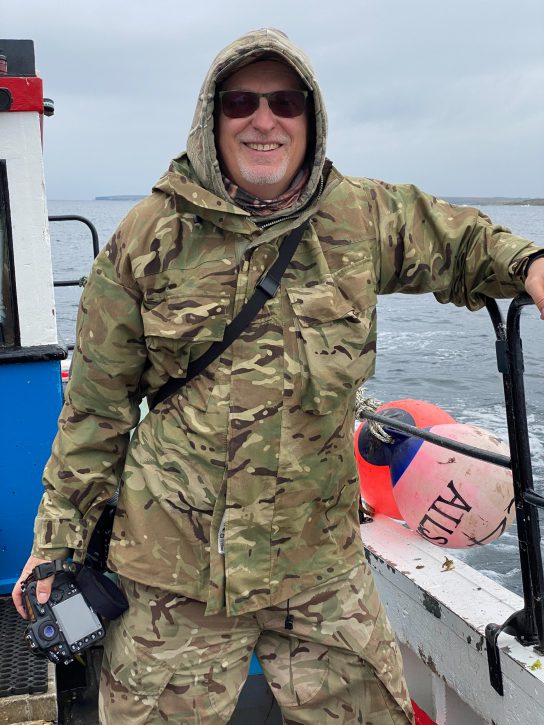
I don’t actually need to be dressed in camouflage but it makes deciding what to wear when I get up in the morning an awful lot easier. Here’s a Great Skua in the water near the boat. I can lie flat here because there’s a platform where the creels descend to the deep. Being eye-level with them is thrilling and disconcerting.
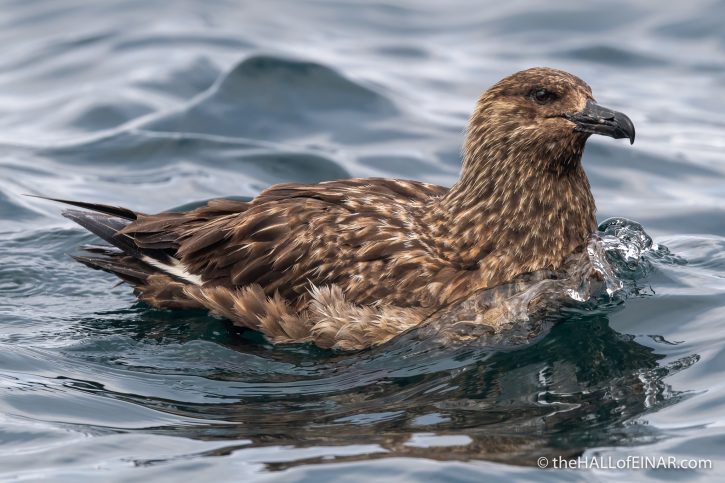
The Atlantic Ocean here is so clear it’s like glass.
The Fauna Orcadensis by Reverend George Low from 1813 has an interesting entry on the Great Skua:
To This Gull we have not in Orkney, neither had I ever an opportunity of seeing it till last summer I met with it in Foula, an island to the westward of the Shetland Isles.
I’m amazed by that. Never seeing one in Orkney?
As I approached the summits of the high mountains, I came near the skua’s quarters, which are affixed on the very peaks. I no sooner approached but I was attacked with so great fury, that every one of those who were with as myself, were obliged to do him obeisance at every stroke. He beat my dog entirely out of the pit, insomuch that he was obliged to run in among our legs for shelter, and could not be forced out again, for though bonxie (as he is here called), had some regard for us while we kept together, on him he had no mercy, every whip he fetched him made his own wings crack, and the dog crouch into the hollows of the moor, till we came up and relieved him. I followed one of them to some distance from the rest, which made me part good company, and received some very rude salutes for my imprudence from three of these birds that made at me with the utmost rage. I defended myself the best way I could with my gun, fired several times at them, but, as none dropped, the report did not startle them in the least, rather seemed to enrage them the more. When the inhabitants are looking after their sheep on the hills, the skua often attacks them in such a manner that they are obliged to defend themselves with cudgels held above their heads, on which it often kills itself.
Hahahaha. “…obliged to do him obeisance at every stroke” is a classic reaction to a Great Skua attack. Have you ever been skewered by one?
The method of life is much the same as in the parasitic gull, only this attacks the larger kind of gulls as the other does the lesser. By the most minute inquiry, could not find that it ever meddled either with its congeners or others to destroy them. Its fury seems to be more defensive than offensive. When we meet it at sea it seems to be a stupid like bird, and often swims within an oar’s length of the boat.
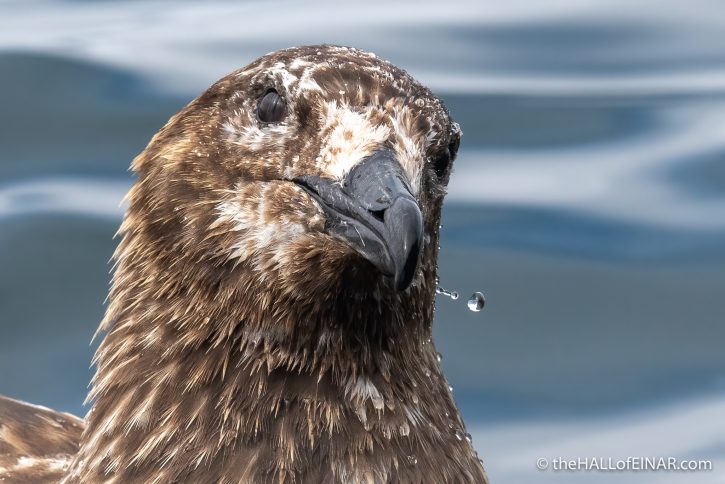
In Foula this is a privileged bird, no man will nor dare shoot it, under the penalty of sixteen shillings and eightpence sterling, nor destroy its eggs. When they meet it at sea whatever fish they have in the boat skua always get a share, and all this out of gratitude for beating off the eagle, who dares not venture to prey on the island during the breeding season. Skua, indeed, is not so strong as the former, but much more nimble, strikes at him without mercy with such effect that he makes the eagle roar aloud, and his retreat is so sudden as to avoid all danger from his clumsier antagonist.
I asked particularly whether skua did not sometimes pay himself for defending their flocks, by taking a lamb now and then, but one and all assured me they had never seen or heard of a single instance of his doing so.
The description of this bird in the British Zoology is pretty good. The neck is much thicker and stronger than in other gulls; the wings reach near the point of the tail; the tail, when flying, is spread like a fan, has no long feathers like the arctic gull; the cry is hoarse and strong: lays two eggs in the heath of the highest hills, much of the same colour as those of the arctic gull, of an olive colour, blotched with darker spots of the same; it weighs three pounds four drachms; length, from the point of the bill to the point of the tail, two feet; breadth four feet and a half; the bill two inches and a quarter, black, strong, and crooked, the base covered with a sort of horny substance; the legs black, webs the same; the talons strong and crooked, especially the innermost, but nothing near equal to those of the smaller birds of prey; the general colour of the upper side of this bird is a rusty-brown. the head, breast, and belly lighter; the quills black towards the upper part, but white towards the wing, which appearing when the bird is on wing forms a white spot: the tail consists of twelve dusky feathers with white roots.
The English name Skua comes from the Faroese skúvur or skúgvur and it is the only bird name to originate from the Faroes in regular use elsewhere.
Here’s a Bonxie chasing a Great Black Backed Gull which has stolen a fish from a Northern Gannet:
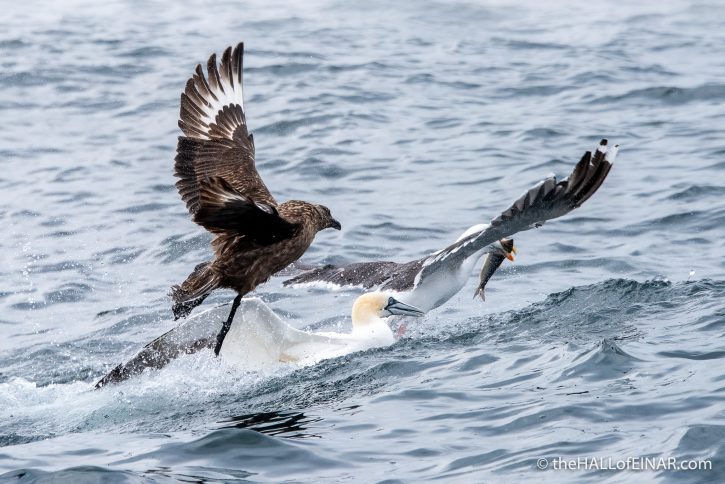
And there’s the usual outcome:
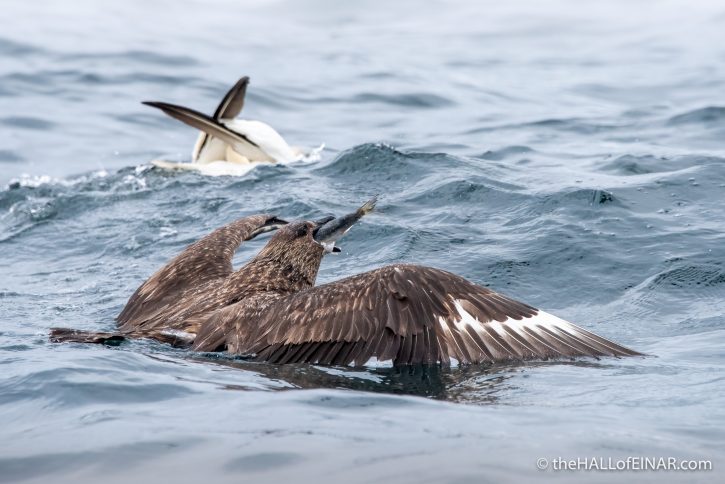
They are a privilege to watch and their determination, power and aggression is awe-inspiring.